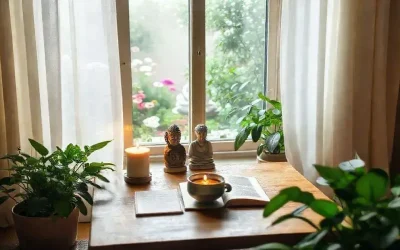Contents
- 0.1 Incorporating various prayer challenges into your routine can significantly enhance your spiritual journey by fostering mindfulness, emotional support, and a sense of belonging.
- 0.2 Engaging in practices such as daily reflection, community prayers, and creative expressions deepens faith and connection, transforming prayer into a vibrant part of daily life.
- 1 Understanding the Importance of Prayer
- 2 Daily Prayer Challenge: 5 Minutes a Day
- 3 Weekly Reflection: Journaling Your Prayers
- 4 Community Prayer Challenge: Pray with Others
- 5 Gratitude Challenge: Thankfulness in Prayer
- 6 Creative Prayer Challenge: Explore Different Styles
- 7 Conclusion
- 8 FAQ – Prayer Challenges and Their Importance
Incorporating various prayer challenges into your routine can significantly enhance your spiritual journey by fostering mindfulness, emotional support, and a sense of belonging.
Engaging in practices such as daily reflection, community prayers, and creative expressions deepens faith and connection, transforming prayer into a vibrant part of daily life.
Are you looking to improve your spiritual routine? Simple prayer challenges can help you deepen your connection to faith.
Incorporating prayer into your daily life offers countless benefits, including emotional support and clarity.
In this article, we’ll uncover six simple prayer challenges designed to enhance your routine and elevate your spiritual journey.
Understanding the Importance of Prayer
Understanding the importance of prayer is foundational for anyone seeking to deepen their spiritual life. Prayer serves as a powerful tool for connecting with the divine, offering a way to express our hopes, fears, and gratitude. It’s not just about asking for help; it’s about building a relationship.
When we pray, we carve out space for reflection and mindfulness, allowing ourselves to slow down amidst life’s chaos. It’s like hitting the pause button on our busy lives, giving us a moment to breathe and tune in to our inner thoughts and feelings.
Moreover, prayer can provide significant emotional and mental benefits. Numerous studies suggest that individuals who engage in regular prayer often report lower levels of stress and anxiety. This practice can help cultivate a sense of peace and clarity, bringing comfort during challenging times.
Importantly, prayer cultivates a sense of community and connection, not just with our own beliefs but with others. Whether through shared prayers, group gatherings, or community services, engaging in prayer can strengthen bonds with friends and family. It fosters a spirit of togetherness, reminding us that we are part of a larger tapestry of faith.
Lastly, prayer encourages gratitude. Acknowledging the blessings in our lives can shift our focus from what we lack to what we have. This shift in perspective often leads to a more positive outlook on life.
In summary, understanding the importance of prayer enriches our lives in many ways, helping us cultivate personal growth, emotional stability, and a deeper sense of connection with the world around us.
Daily Prayer Challenge: 5 Minutes a Day
The Daily Prayer Challenge: 5 Minutes a Day is a simple yet transformative practice that can fit seamlessly into your routine. Dedicating just five minutes each day to prayer creates an opportunity for reflection, gratitude, and spiritual connection without overwhelming your schedule.
To start, find a quiet space where you can be alone with your thoughts. This could be a cozy corner of your room, a peaceful spot in your backyard, or even a nearby park. The key is to choose a place that feels comfortable and free from distractions.
Begin your five-minute prayer time by taking a few deep breaths to center yourself. This helps clear your mind and prepares your heart for communication. You might want to open with an expression of gratitude, acknowledging the blessings in your life, no matter how small. This sets a positive tone for your prayer.
During these five minutes, you can express your thoughts and feelings freely. Whether you’re sharing your worries, hopes, or dreams, allow yourself to be authentic. Don’t worry about eloquence; focus instead on honesty and sincerity. If you’re unsure what to say, consider using a prayer prompt or scripture to inspire your conversation with God.
One effective method is to structure your prayer time like this:
- Gratitude (1 minute): Thank God for specific blessings in your life.
- Reflection (2 minutes): Share your thoughts, worries, and desires. Ask for guidance or support where needed.
- Listening (2 minutes): Spend the last moments in silence, opening your mind and heart to receive any insights or feelings.
Over time, this daily practice can become a comforting ritual. It offers a moment to pause in a busy day, fostering a deeper sense of peace and awareness of the divine presence in your life. Plus, it’s only five minutes—everyone can squeeze that into their day!
By committing to this challenge, you’ll likely find that these small pockets of prayer lead to meaningful experiences and a greater sense of spiritual fulfillment.
Weekly Reflection: Journaling Your Prayers
The Weekly Reflection: Journaling Your Prayers challenge invites you to delve deeper into your spiritual practice by capturing your thoughts and feelings on paper. This process not only creates a tangible record of your prayer life but also allows for introspection and growth.
To get started, set aside a specific day of the week for your reflection. Pick a time when you can be undisturbed and truly focus on the experience. You might choose Sunday, allowing you to reflect on the past week and set intentions for the upcoming one.
Your journaling setup can be as simple or as elaborate as you prefer. Grab a notebook that resonates with you, or create a digital document if that’s more your style. The important thing is to have a dedicated space for this practice.
Begin your journaling session by revisiting the prayers you’ve expressed throughout the week. You can look back at any notes or recordings you might have made, or simply reflect on your conversations with God. Ask yourself questions like:
- What themes or concerns have emerged in my prayers?
- How did I feel during my prayer times?
- Were there any moments that stood out to me?
- What insights or guidance do I feel I’ve received?
Allow your thoughts to flow freely as you write. There are no right or wrong ways to journal; just write what comes to mind. You might jot down specific prayers, thoughts on faith, or even sketches that represent your feelings. The act of writing can help clarify your emotions and deepen your understanding of the journey.
In addition to reflecting on your prayers, you can use this time to set intentions for the upcoming week. What would you like to focus on in your prayer life? Are there specific challenges you want to lift up in prayer? Making these intentions can help guide your thoughts and prayers as you move forward.
Over time, reviewing your journal entries can reveal patterns in your prayer life and spiritual growth. You might notice recurring themes in your requests or shifts in how you perceive your relationship with God. This insight can be invaluable, serving as a reminder of how far you’ve come, both emotionally and spiritually.
Overall, journaling your prayers not only enhances the act of prayer but also invites a deeper connection with yourself and the divine.
Community Prayer Challenge: Pray with Others
The Community Prayer Challenge: Pray with Others is about fostering connection and support within your faith community. Joining together in prayer can amplify your spiritual experience, creating an atmosphere of shared faith and encouragement.
To get started, consider organizing a small prayer group with friends, family, or fellow church members. You don’t need a large gathering; even a handful of people can create a powerful prayer circle. Choose a comfortable space where everyone can feel relaxed and open.
During your first meeting, set a welcoming tone. This can be as simple as starting with a light discussion about what prayer means to each participant. Encourage everyone to share their thoughts and feelings, helping to create an environment of trust and vulnerability.
Once everyone feels comfortable, you might want to structure your prayer session. Here’s one approach you could follow:
- Opening Prayer (5 minutes): Start with a brief prayer asking for guidance and openness during your time together.
- Sharing Intentions (10 minutes): Allow each person to share what’s on their heart. This might include personal struggles, blessings, or specific prayer requests.
- Group Prayer (15 minutes): You can choose to pray for each other individually or collectively as a group. Consider taking turns—allowing each person to lead a prayer or simply voice their intention.
- Closing Reflection (5 minutes): End your session with a moment of silence or a final prayer of gratitude, acknowledging the shared experience.
As your group becomes more comfortable with one another, you can explore different ways of praying together. You might want to try thematic prayers based on current events, or even explore prayer walks in your community, where you pray for specific neighborhoods or challenges in your area.
Involving children or youth in the prayer challenge can also bring fresh perspectives and help to develop their understanding of faith. Consider organizing a family-oriented prayer night where everyone, regardless of age, can participate and learn together.
Participating in community prayer can greatly enhance your spiritual journey. It opens the door to support from others, encourages accountability, and provides a sense of belonging. Plus, witnessing how others experience prayer can enrich your own practice and perspective!
Ultimately, this prayer challenge not only deepens your relationship with the divine but also strengthens the bonds with those around you, creating a tighter-knit and supportive community.
Gratitude Challenge: Thankfulness in Prayer
The Gratitude Challenge: Thankfulness in Prayer is a heartwarming practice that encourages us to focus on the positive aspects of our lives through intentional expressions of gratitude. By making thankfulness a regular part of our prayer routine, we can shift our perspective and cultivate a more joyful spirit.
To embark on this challenge, set aside time each day dedicated to gratitude. This could be part of your morning prayer or an evening reflection before bed. Choose a quiet spot where you can pause and reflect on your day.
Begin by taking a deep breath to ground yourself. As you settle in, start listing out specific things you are grateful for—aim for at least three to five items each day. They can be big or small, from the support of a loved one to the warmth of the sun on your skin. It’s about recognizing and acknowledging the blessings you might otherwise overlook.
Your gratitude expression can take various forms. You might choose to:
- Make a List: Write down your gratitude points in a journal. Seeing them on paper can reinforce your awareness of the goodness in your life.
- Verbalize Your Thanks: During your prayer time, speak out loud what you are thankful for. This act of vocalization can deepen your connection to these feelings.
- Create a Gratitude Jar: For a fun twist, use a jar to collect notes of gratitude throughout the month. Each time you write down something you’re thankful for, place it in the jar. At the end of the month, open the jar to reflect on all the blessings you’ve noted.
Incorporating gratitude into your prayer life not only fosters a sense of contentment but also helps shift your focus from what’s lacking in your life to what you already have. Studies have shown that regularly practicing gratitude can lead to reduced stress levels, increased happiness, and a greater overall life satisfaction.
One way to deepen this challenge is to encourage others to join you. Sharing your gratitude with family or friends can create a ripple effect of positivity. Perhaps schedule a weekly dinner where everyone shares something they are thankful for. This can lead to deeper conversations and strengthen relationships.
Lastly, don’t forget to thank others in your prayers. Expressing appreciation for people in your life can enhance your connections and foster a spirit of community. Remember, it’s the little things that often matter the most!
By embracing this gratitude challenge, you’re not only enhancing your prayer life but also enriching your overall outlook on life—a beautiful journey towards greater joy and fulfillment.
Creative Prayer Challenge: Explore Different Styles
The Creative Prayer Challenge: Explore Different Styles encourages you to break free from traditional prayer routines and discover new ways to express your spirituality. This challenge invites variety and creativity into your prayer life, making it more engaging and meaningful.
To begin, consider trying different prayer styles, each with its own unique approach and focus. Here are a few options to inspire you:
- Artistic Prayer: Use your creativity to pray through art. This could mean painting, drawing, or even coloring in a prayer journal. Don’t worry about your artistic skills; focus instead on the process and how it helps you express your feelings and thoughts.
- Movement Prayer: Engage your body in prayer through dance or yoga. Moving your body can help you connect with your spirit in a new and liberating way. Choose songs or movements that resonate with you, allowing your body’s motions to reflect your prayers.
- Nature Prayer: Take your prayers outdoors. Spend time in a garden, park, or natural setting, using the beauty of creation to inspire your thoughts and gratitude. You might walk silently and meditate or verbalize your prayers as you observe the world around you.
- Scripture Prayer: Use verses from the Bible or other spiritual texts as a foundation for your prayers. Reflect on a specific passage, meditate on its meaning, and personalize it by turning it into a prayer. This can deepen your understanding of scripture and enhance your communication with God.
- Music Prayer: Explore prayer through music. Listen to your favorite worship songs or create playlists that inspire you. You might pray along with the lyrics, or use music as a backdrop for your silent reflections.
Set a theme for each day or week to keep your prayer style fresh. For instance, dedicate weekdays to different types, such as Artistic Monday or Nature Thursday. Mixing it up can prevent monotony and keep your prayers alive and exciting.
As you experiment with these creative approaches, pay attention to how they affect your feelings and spiritual connection. You might find certain styles resonate more deeply with you, or perhaps you discover new aspects of your faith that you hadn’t considered before.
Involving others in this challenge can be particularly enriching. Organize a creative prayer night where friends bring their own artistic materials or musical instruments. Sharing and experiencing each other’s creative expressions of prayer can create a powerful sense of community and support.
Ultimately, the goal of this Creative Prayer Challenge is to foster a more dynamic and fulfilling prayer life. By embracing creativity, you’re not only honoring your spirituality but also nurturing a deeper relationship with yourself and the divine.
Conclusion
Engaging in the various prayer challenges discussed—whether it’s dedicating five minutes a day, journaling, praying within a community, expressing gratitude, or exploring creative styles—can significantly enhance your spiritual routine.
Each of these practices offers unique benefits, helping you to connect more deeply with your faith and with others around you.
As you incorporate these challenges into your life, remember that the essence of prayer lies in authenticity and openness. It’s less about the form and more about the heart behind it. Embrace the journey, allow yourself to grow through your experiences, and remain open to the ways that prayer can transform your daily life.
Ultimately, these challenges are not just about setting goals but about nurturing a profound relationship with the divine and discovering the many dimensions of prayer. With persistence and creativity, you’ll find yourself enriched spiritually and personally as prayer becomes a vibrant and integral part of your life.
FAQ – Prayer Challenges and Their Importance
What is the purpose of the Daily Prayer Challenge?
The Daily Prayer Challenge encourages dedicating just five minutes a day to prayer, fostering a deeper connection and mindfulness in your spiritual routine.
How can journaling my prayers benefit me?
Journaling allows for reflection on your prayer life, helps track your spiritual growth, and can reveal patterns and insights over time.
Why is community prayer important?
Community prayer fosters connection and support among individuals, creating a sense of belonging and encouragement while experiencing shared faith.
What is the Gratitude Challenge about?
The Gratitude Challenge involves intentionally expressing thankfulness during prayer, helping shift your focus to the positive aspects of life, leading to greater joy.
How can I explore different prayer styles?
You can explore various prayer styles like artistic prayer, movement prayer, or nature prayer to enrich your spiritual experience and keep your practice dynamic.
Can I involve others in these prayer challenges?
Absolutely! Involving friends and family can enhance the experience, create community support, and deepen relationships through shared spiritual growth.






















